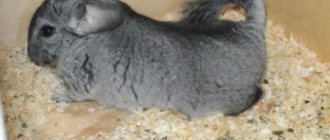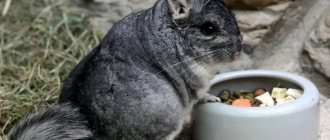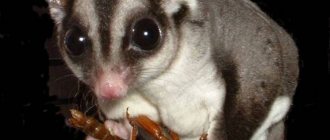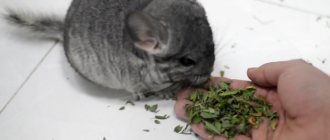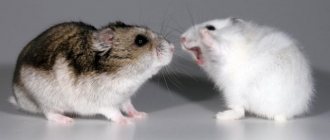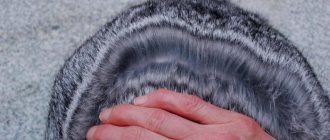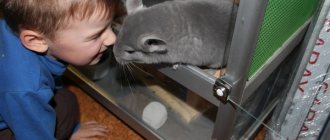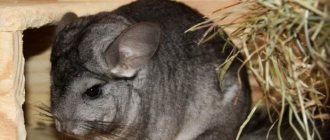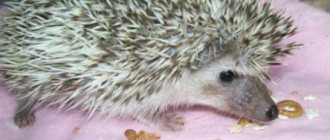The chinchilla is a small herbivorous rodent with thick and soft fur. It is not difficult to have such an animal as a pet. It is unpretentious in food and maintenance, and its life expectancy in captivity is on average 10-12 years. Exotic rodents can bring their owner not only positive emotions, but also a good income.
The value of chinchillas is due to their very thick and dense hair. The fur is so thick that it doesn’t even harbor parasites. Chinchillas do not shed, and their fur does not cause allergies. Therefore, its cost is much more expensive than the cost of arctic fox, mink or sable fur. The demand for items made from chinchilla fur is growing, while materials often have to be imported from abroad. Competition in the market of the Russian Federation and CIS countries is low, which significantly increases the chances of a successful business in raising and breeding these animals.
You can breed chinchillas at home for sale. Many people love these cute furry animals, but buying them at the bird market is dangerous. The cost of one individual fluctuates in a fairly wide range - from 1,000 rubles. up to 40,000 rubles, and sometimes higher. It all depends on the color, quality of fur, size or gender.
The most important thing about such a business idea is that there is no need to rent premises or hire workers. You can set up a mini-farm for growing chinchillas right at home.
Where to start breeding chinchillas as a business at home
In addition to the fact that you need to acquire at least a couple of individuals, you have to complete the following activities:
- Develop a business plan for raising chinchillas at home.
- Prepare a room intended for the farm.
- Purchase the necessary equipment: food, sawdust, cages, toys.
- Place animals on the farm and provide them with a comfortable stay.
- Think over legal ways to receive income from the sale of products: register a business, determine the appropriate tax regime, understand the reporting.
IMPORTANT
: For the cultivation and sale of this type of product, permission from regulatory authorities and licenses are not required.
You need to understand how to breed chinchillas at home. In 1 year, the female produces up to three litters. One litter can have 1-3 cubs. With relatively small capital investments, starting a business requires a large time investment. However, the return on investment is high.
conclusions
Chinchilla fur occupies a strong place in the global fur market. But this is not a mass product, but an expensive exclusive product. Accordingly, those who buy it are very demanding on quality. This means that if you are planning to open a chinchilla breeding farm, you must first of all purchase expensive, preferably imported, breeding specimens. You will receive your breeding herd no earlier than in 2–3 years.
In addition, you need to rely on your own slaughter and sanding. It is not profitable to trade young animals. Finding buyers for a really good product will not be difficult. It is more difficult to produce high-quality products: it is about 1,000 identical good skins.
In Russia, the number of “chinchilla” enthusiasts is increasing every year, but so far there are few farms with more than 300 chinchillas. Most of them make ends meet by selling breeding animals, feed and related materials. Wholesale resellers make money mainly from fur.
Selection and preparation of premises
Despite the fact that chinchillas are extremely unpretentious, you should approach the choice of premises responsibly. A number of conditions must be met:
- One individual needs about 0.3 m2 of area;
- permissible room temperature – 18-20 degrees;
- air humidity should not exceed 60%;
- it is important to make sure there are no drafts;
- the room must be clean;
- there should be little light, rodents do not like bright rays;
- The level of noise and harsh sounds should be minimal.
Take care of regular cleaning and ventilation. The appearance of mold or mildew in the room is unacceptable. The best solution would be to fence off the chinchilla farm from other buildings. Remember, animals are very shy, especially during the mating period.
Business relevance
It's no secret that chinchillas are one of the most expensive and sought-after fur products in the world of the fashion industry. But this is not all the advantages of a fur-bearing animal. Its meat is dietary and is used for medicinal purposes. It is recommended for tuberculosis and indispensable for sclerosis. Scientists have also been able to prove that this meat makes it possible to treat cancer.
Few people know that chinchillas are unique animals. They live in places where gold and precious stones are placed nearby. Since ancient times, treasure hunters around the world have used these animals to find treasures.
Today, treasure hunters have changed their status to entrepreneurs and receive excellent income from breeding these animals. Let's consider the features and pitfalls of this business.
Purchase of cages and equipment
Having prepared the room, proceed to purchasing a cage and related equipment. Avoid any wooden parts - rodents will quickly make short work of them. It is forbidden to paint the room, as animals cannot tolerate the smell of chemicals very well.
The optimal cage size can be considered 50/50/60 cm. You can purchase a larger enclosure - it all depends on how many individuals you plan to have. The main condition is about 30 cm2 per individual. Males and females can be housed in pairs or separately, it all depends on the method of reproduction and the nature of the pets. Chinchillas are very agile rodents, so the cage should have small cells so that they cannot get out of it. When choosing a cage, pay attention to its safety and ease of cleaning. Experienced breeders place 6 cells in 2 rows. With this arrangement, the required area will be about 18 m2.
You will need:
- Sippy cup. It is best to choose hanging drinking bowls with automatic water supply.
- Hopper type feeder.
- Bath for bathing with sand. It should be spacious enough with closed sides.
- Bed or house.
- A house for a female during childbirth.
- Tray at the bottom of the cage.
- Toys - running wheel, tunnels, balls.
- Trainers for teeth. These can be mineral stones or pumice.
Remember that pets need to jump and move a lot, so make sure that the house has various shelves and perches. The distances should not be large so that the animal does not damage its paw when landing.
How to keep fur animals?
The chinchilla breeding business can be compared to buying a new car. Before getting behind the wheel, a motorist must undergo training, pass an exam and obtain a license. Also here, before you buy animals you need to know everything about them.
Business Features
- Chinchillas don't shed
- Dry mixtures can be permanent food for animals.
- Raising animals is not difficult
- Special equipment is more of a luxury than a necessity
- Animals must be kept in a room free from drafts, moisture and dirt.
- The premises must comply with SES requirements
- The room in which the animals are kept must be heated
- Animals should be placed in separate cages upon reaching 3 months of age.
- Only quality individuals should be selected for breeding
- Chinchillas are caught only by the tail or ear, and this should be done as rarely as possible.
- You can’t skimp on sand for animals, this can negatively affect their fur coat
Growing technology
- When organizing a farm, an entrepreneur should know that chinchillas are nocturnal inhabitants, so sound insulation is of great importance.
- The optimal parameters for cells are 50/50/60 cm.
- The animals should be fed 2 times, 1 time with hay, 2 times with mixed feed. Animals should be given an apple and vitamins 2-3 times a week.
- Feeding is best done in the evening.
- There should always be water in the drinking bowls of the cells.
- Cleaning is done once a week.
- Disinfection is carried out once every 30 days.
Reproduction of chinchillas on a farm
Every year, one female can give birth to three litters of up to 4 puppies each. The animals will be old enough to reproduce by the age of 5 months, but mating is not recommended until a year.
Animals can be placed in cages using a monogamous or polygamous method, i.e., in pairs or families. It is recommended to keep animals in pairs for up to 2 years, while the herd nucleus is formed. Such pairs will produce the highest quality litter. After reaching this age, the animals should be housed polygamously in groups of 5 individuals (1 male and 4 females).
Puppies that are born weigh up to 250 grams, and 2 months after birth they should be separated from their mother, allowing the lactation period to end.
Chinchillas mate at night, and in order to determine pregnancy, you should monitor the weight of the female, who will gain about 50 grams every 14 days. Before giving birth, the male should be separated 10 days before; usually, labor begins at 6 a.m. and lasts several hours.
Breeding problems
Growing chinchillas, like any other type of business, may be associated with certain problems or risks for the entrepreneur:
- Chinchillas are living creatures with their own character and disposition, so it is impossible to predict how the animal will react to its owner, neighbor, male or puppies. That is why you should carefully monitor the relationship between children and parents, and if there is a threat, place the offspring in another cage.
- Inbreeding among such animals is strictly prohibited.
- By their nature, chinchillas are territorial animals and may react negatively to a stranger. Therefore, individuals should be introduced gradually, giving them the opportunity to get used to each other.
Features of choosing and purchasing breeding stock
Once you have prepared the room and cage, it is time to start purchasing livestock. For a home mini-farm, it is enough to purchase 2 males and 10 females. Such a set can produce 70-80 young animals in 1 year.
Many breeders and farms provide temporary males for mating - consider these options.
There is an opinion that chinchillas should be bred monogamously, i.e. form pairs and let them breed separately. This method has a number of advantages, but is more expensive.
Buy young animals only from large and trusted breeders. This way you will protect yourself from buying a sick animal. In addition, breeders can provide a guarantee and a breeding card.
Nutrition
The main food consists of specialized granulated food, hay and water. In this case, the food should be produced only for chinchillas. It cannot be replaced with food for rabbits, hamsters or other rodents.
It is cheaper to buy feed from farms, since highly specialized retail outlets add substances that allow the product to be stored for a long time, but it does not bring any benefit to the animal. Remember, the best food source is clean pellets. Do not buy food in the form of rings, seeds, cereal grains, etc.
The water must be filtered; it is not recommended to use boiled water. Hay should be green, fresh and clean. Do not use hay for bedding as it will become contaminated. If the animal eats it, it will lead to poor digestion or bloating.
Chinchilla breeding
The female is ready for reproduction at the age of 4-7 months, the male at 7-9 months. In breeding conditions, one female can bear offspring without harm to health for 8 years. An older female will also produce offspring, but the cubs will be weaker and sicker.
Mating usually occurs at night. If fertilization has occurred, you will find tufts of fur and small waxy flagellum in the cell. Next, the female will gain approximately 100g. every two weeks. A pregnant female should be given more vitamins. The gestation period is 104-115 days. A couple of weeks before giving birth, the female needs to equip a room with sawdust and block the road to the bathing bowl. Monitor the behavior of the male; if he interferes, he should be isolated.
Childbirth usually takes place in the morning and no human intervention is required. When breeding polygamously, the male should be isolated from the female and the young for a couple of weeks. With the monogamous method, the male can be left in the cage. However, remember that immediately after giving birth, the male will try to cover the female again. One female can become pregnant up to 3 times a year, so make sure that her health is not compromised.
Young animals weigh from 30 to 70 g. Newborn babies are able to move independently. Milk feeding lasts up to 60 days, after which the young animals can be weaned from their mother. If the female does not have milk, the babies are transferred to one who has recently whelped, or are transferred to artificial feeding.
Pair formation
It is at this age that the reproductive system matures and animals can be distinguished by gender characteristics. In a male, there is a distance of several millimeters between the anus and the penis, but in a female, there is no gap between the vagina and the anus.
Chinchillas are polygamous animals and one male can cover three or four females. When forming pairs, the female is placed next to the male. Let's consider the difficult moment of forming a pair, because in severe cases rodents can seriously injure each other. What do we have to do:
- We place the pair in cages next door for a couple of days;
- Next, we place the animals in a small carrying cage for several hours;
- At this time, we prepare the cage for mutual living, change the filler and carry out general cleaning;
- We launch the first male to prepare and mark the territory;
- And last we launch the female.
This scheme will help avoid conflict situations.
Care and maintenance of chinchillas at home
The chinchilla is unpretentious and does not require careful care. It is enough to clean the cage daily and ensure the availability of fresh water and food. The bedding in the cage should be changed once a week. Once every six months it is worth checking the cage for integrity and disinfecting it. Wet cleaning of the premises is recommended once a month.
You can buy food in specialized stores or prepare it yourself by mixing different types of grains. In addition to cereals, chinchillas love hay and dry dandelion leaves. In summer, you can add fresh grass to your diet. In winter, animals are given carrots and apple pieces. Feeding occurs once a day in the evenings. For 1 animal there is up to 50g. stern. If there is a lack of sunlight, add liquid vitamin D to the food.
What you need to know about diseases
For many owners, this part of the article will be useful so that in case of unforeseen situations they know how to help their pet.
The following table shows the most common diseases:
| Name of the disease | Why does it occur | Symptoms | How to treat |
| Digestive system disorder | Poor quality food, non-compliance with the feeding regime, transfer of the animal from dry food to natural | Presence of constipation or diarrhea, inflammation of the gastrointestinal tract, feces with bloody discharge | Be sure to invite a veterinarian to diagnose the disease and prescribe treatment |
| Gnawing of fur | Presence of itchy skin, blood-sucking insects, lack of vitamins | The animal begins to chew out its own fur or the fur of cage mates | A veterinarian examination and tests are required. As a preventative measure, it is necessary to replace the diet and maintain cleanliness in the cage. |
| Hepatic dystrophy | Poor quality food, carotene is no longer absorbed by the animal’s body | Replacement of liver cells with adipose tissue | Review of the diet; fatty foods must be removed and replaced with a high-quality diet. You can put a wheel in the cage to help the animal keep itself in shape. |
| Stones in the genitourinary system | Incorrectly composed diet | It is necessary to do an ultrasound; if large stones are present, surgical intervention is prescribed | |
| Overheating or hypothermia of the body | Unsuitable temperature conditions | The animal spends a lot of time lying down, has difficulty breathing, loses consciousness | Transfer the chinchilla to a suitable room with the right temperature. If necessary, call a veterinarian |
| Conjunctivitis | Various injuries, reaction to a chemical irritant | Inflammation of the conjunctiva | Treating cells with antiseptic solutions. Chamomile decoctions and boric acid are used for treatment; if necessary, the veterinarian prescribes drops |
| Inflammation of the mucous membranes of the nasal cavity | Reaction to changing weather conditions, a sharp decrease or increase in temperature, drafts in the room | Presence of mucous discharge from the nasal cavity, refusal to feed, rapid breathing, temperature above normal | Transfer the animal to a dry, warm room, introduce vitamins into the diet, consult a veterinarian |
| Presence of injuries | Occur during fights or an accidental blow to a sharp corner of the cage | Skin damage, bleeding | Minor superficial scratches will heal on their own. Deeper injuries should be examined by a veterinarian |
| Having dental problems | Inability to grind teeth on your own | Refusal of feed | Correction is carried out in the hospital, as a preventive measure it is necessary to introduce twig feed into the diet |
Sale of chinchillas, markets for products
The best option for home farms is the sale of live animals. Your clients can be individuals, stores or wholesale buyers.
Sales can be divided into the following categories:
- Realization of marriage. Culled chinchillas are a common occurrence on chinchilla farms. We are not talking about weak and sick animals. Rejects are those individuals that are not suitable for reproduction, or those whose fur turns out to be of poor quality. Clients in this case can be bird markets, pet stores or individuals who want to get an exotic pet. The cost of sales will depend on the average prices in your region. As a rule, it is low - from 2,000 to 5,000 rubles. for one animal.
- Sales of breeding animals. It is possible to raise chinchillas intended for breeding. In this case, the clients will be beginning breeders or farms that require breeding material. The cost of implementation here is much higher. It all depends on the breed, age, gender, external parameters.
- Fur sales. This type of implementation is preferable for large farms with a population of 300 males or more. It is the fur of male chinchillas that is considered to be of higher quality and is used in the production of various products. Clients are large fur studios in big cities. Cost – from 7,000 rubles.
- The most profitable market for chinchilla fur is auctions. The cost of one skin when traded under a hammer can reach tens of thousands of rubles. However, to get into this niche, as a rule, a home chinchilla farm is not enough. Larger production volumes and animals of rare and valuable breeds are required.
Income from the nursery
Before starting to implement the idea of breeding chinchillas, you need to calculate not only the costs, but also the profitability of the business.
- The main direction is the fur industry, which requires precious skins. Sale by live weight or individual items is possible - the farmer independently butchers the carcasses and brings the skin to marketable condition.
- There is also a demand for meat, because its quality is high and can compete with rabbit, turkey and other types.
- Keeping chinchillas as pets is popular. You can sell small animals through pet stores or through advertisements.
- Sale of young animals by families to other breeders.
Each direction can generate income. Starting with 10 families, within a year you can get an increase in the number of up to 270 units if each female produces 9 healthy cubs in three lambings. 3-month-old chinchillas are suitable for sale as pets. At this age, they are separated from their mother and transferred to an independent existence.
The animal reaches marketability for sale to fur partners at 9 months. Males usually go for these purposes if there are many of them in the offspring. The table shows the sales of products for the year and the amount of proceeds. We sort from 250 pieces, leaving 20 young individuals for the development of the farm.
| Type of implementation | Number per year | Price for 1 unit, rub. | Income | Comments |
| Sales to partners by live weight | 150 | 8 thousand | 1 million 200 thousand | The price depends on the terms of the partnership. |
| Sale of skins | 50 | 4 thousand | 200 thousand | The price is affected by the type of animal, the size and quality of the skin. |
| Sale of meat | 50 | 1 thousand | 50 thousand | |
| Sale for home use from 3 months of age. | 50 | 6 thousand | 300 thousand | The older the animal, the higher its price. |
| Total income | 250 | – | 1 million 750 thousand | Subject to the survival of the offspring and the sale of the entire livestock. |
If sales channels are found, the annual income can be significant, given that current costs go only to feed, vitamins, and providing comfortable living conditions for animals. It is worth making an explanation of the number of chinchillas that will be marketable in the first year of opening the farm:
- It takes time for the offspring to appear (111 days from the moment of fertilization).
- Not all babies in a litter may be healthy. Young females can produce one or two healthy offspring. The young need care for up to 3 months, which may delay the period of the second mating. As a result, in a year the female will give not 9, but only 4 kittens.
- Selling pets to other breeders or for pet keeping is more profitable than slaughtering an animal for its skin and meat. Without constant requests, the goods may be damaged. Inexperience in cutting a carcass will lead to damaged fur and losses.
To determine the profitability of chinchilla breeding and the timing of reaching self-sufficiency, for calculations we will take a smaller amount of the farm’s annual revenue (950 thousand) and take into account the farm’s fixed costs:
| Operation | Funds, rub. |
| Annual revenue | 950 thousand |
| Current expenses for the year: | 440 thousand |
| Food, vitamins, additional items for keeping animals (sand, gravel, sieve, drinking bowls, veterinarian services) | 150 thousand |
| Utility costs (light, heating, water) | 60 thousand |
| Facility security | 60 thousand |
| Fare | 25 thousand |
| Male Update | 50 thousand |
| Processing of hides to marketable condition | 15 thousand |
| 50 thousand | |
| IP payments | 30 thousand |
| Revenue before taxes | 510 thousand |
| Unified agricultural tax | 31 thousand |
| Net income for the month | 40 thousand |
| Investments | 340 thousand |
| Project payback period | 8–9 months. |
Within a year, the farm will reach self-sufficiency and bring a net profit to the owner in the amount of 80–100 thousand rubles, which can be invested in expanding the farm’s volumes.
Possible risks
When planning this type of business, be sure to consider all possible risks. The biggest danger is the loss of animals. The disease of the entire livestock can lead to very unpleasant consequences. Despite the fact that chinchillas are not susceptible to diseases, they require careful care. When purchasing a new individual, monitor its behavior for a couple of days. Poor nutrition can lead to illness. Under no circumstances should you wash animals with water - this will make their fur worse.
Considering competition as a risk for doing business does not yet make much sense. Chinchilla breeding has not yet become widespread and this niche remains relatively free. However, it is still worth monitoring the state of the market in your region; perhaps there is a large breeder and seller of these animals very close by. Don't be afraid of competition, observe and learn from positive experiences.
Expenses
Breeding chinchillas as a business requires certain expenses. The first thing to consider before starting breeding is the cost of creation.
For the farm you need to purchase:
- trolleys;
- accessories such as feeders,
- feed, hay;
- materials and equipment for dusting and watering.
These items, as well as cages, can cost tens of thousands of rubles. And that doesn't include buying chinchillas or veterinary bills. A breeder should always buy quality purebred animals.
It is important to know that chinchillas purchased from pet stores should not be used for breeding. Because there is no way to know if they have any genetic problems
Moreover, it is often possible to purchase a breeding quality animal cheaper from a reputable breeder.
On average, a chinchilla for breeding costs between $10 and $50. Depending on its color, quality and display. If you start with one pair of quality chinchillas and the necessary supplies, it can cost $100 or more.
Reviews from experienced farmers
Nikolay Petrovich, Moscow region:
When I retired, I was bored without work. It was my grandchildren who came up with the idea to start breeding chinchillas. I started with 30 animals, placed them in the garage, but those who do not have a private farm can raise animals at home, since they do not have dirt or unpleasant odors. Now I am planning to expand, I have already started making new cages, purchased food and agreed with the farm on the supply of breeding females. I rent males.
Irina, Kursk:
I have two years of experience working with chinchillas. My husband and I started with just one family, today we have more than a hundred animals on our farm, and we won’t stop there!
Automation of production and well-established sales of products allow you to manage a large number of animals and have a good income. The plans include entering the international market. The main thing in care is to maintain temperature conditions and not skimp on sand! The animals will do the rest themselves: they will sharpen their teeth and clean their fur coat.
Source
